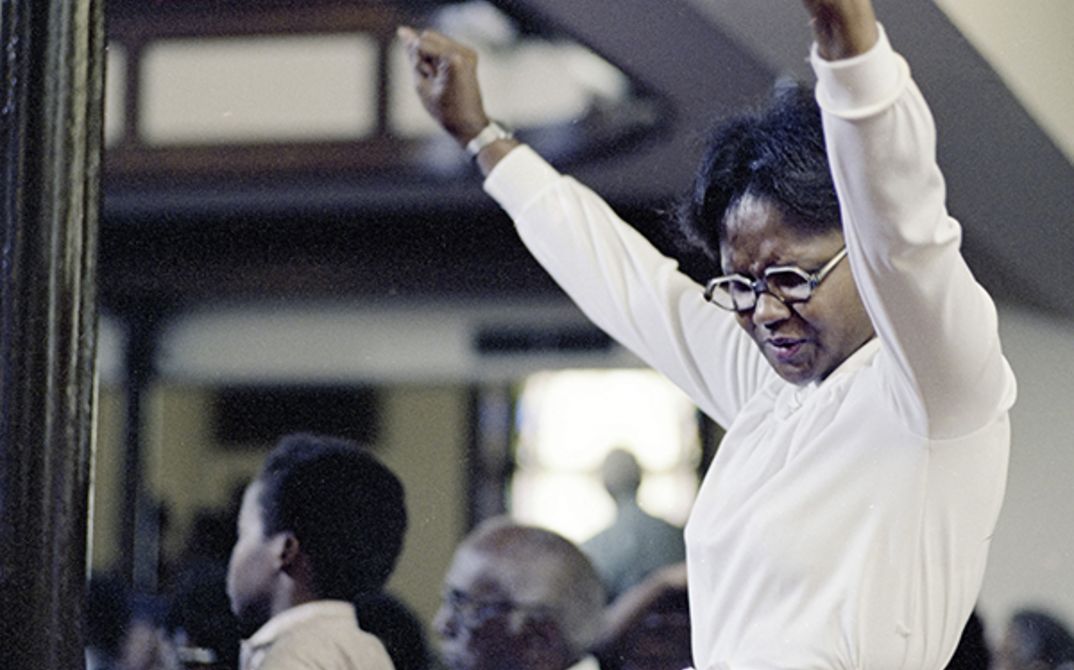The pioneers of Gospel
After I made my film on black jazz tap dancing, NO MAP ON MY TAPS, I developed a fascination with the roots of American culture. I was looking for an idea for another project when one night I was at dinner with the Grammy Award-winning musician Ry Cooder, and he said, “You ought to look into gospel music. Those ‘cats’ are really neat!” That’s how it started. I knew little about gospel music before starting work on SAY AMEN, SOMEBODY, which allowed me to approach the subject without any preconceived notions.
In 1981, at the age of 27, I started going to African American churches throughout New York City, where I had my first experiences of gospel music, met gospel musicians and learned about the music’s role within the church-going context. At the National Convention of Gospel Choirs and Choruses, I met two pioneers of gospel music: Thomas A. Dorsey, the father of gospel music, and Mother Willie May Ford Smith, considered one of the greatest gospel singers of all time and the embodiment of the unity between music and religion that is at the heart of gospel music.
They became central characters in the film, along with members of the next generation of gospel singers they were nurturing. They all welcomed me into their world, and our connection was immediate. In order to get to know them better and meet the people they influenced, I spent time with them, their families and their communities in Chicago and St. Louis. They shared their inmost stories about their lives, hopes and frustrations.
Over the next year, I recorded hours of interviews and took hundreds of photographs. It was a way of developing intimacy with these wonderful people while also working on the structure of the film, figuring out which parts of the protagonists’ lives I would include in the film. My goal was to convey to the viewer the same emotions that the music triggered in me, and to give a voice to the people in the film in order to grant the viewer a deep and personal connection to their stories.
Intolerant church
SAY AMEN, SOMEBODY tells the history of evangelical gospel music from the perspective of its pioneers and shows how they fought to be allowed to play this music in churches. The film is a document of the dedication of the early gospel musicians and of the price that they and their families had to pay for their engagement.
In order to grant deeper access to the subject matter, all my films address the viewer on at least three different levels simultaneously. They are multi-layered and revolve around more than just their apparent topic. SAY AMEN, SOMEBODY also shows the women’s struggle against patriarchal social structures, as well as the relationships within families and the state of gospel music at the time. Similarly, my film THAT RHYTHM… THOSE BLUES thematised the early days of the civil rights movement through the experiences of its representatives in the music industry. Whereas NO MAPS ON MY TAPS tells the story of tap dance not only as an art form but also as an expression of African American heritage and culture. The openness with which the protagonists of all my films embraced me is both an honour and deeply humbling. It is a blessing for me to have been allowed to share in their passions and vocations. (George T. Nierenberg)
No educational film
SAY AMEN, SOMEBODY is the most joyful movie I've seen in a very long time. It is also one of the best musicals and one of the most interesting documentaries. And it's also a terrific good time.
The music in SAY AMEN, SOMEBODY is as exciting and uplifting as any music I’ve ever heard on film. The people in this movie are something, too. The filmmaker, a young New Yorker named George T. Nierenberg, starts by introducing us to two pioneers of modern gospel: Mother Willie May Ford Smith, who is 79, and Professor Dorsey, who is 83. (…) The film opens at tributes to the two of them – Mother Smith in a St. Louis church, Dorsey at a Houston convention – and then Nierenberg cuts back and forth between their memories, their families, their music and the music sung in tribute to them by younger performers. That keeps the movie from seeming too much like the wrong kind of documentary – the kind that feels like an educational film and is filled with boring lists of dates and places. SAY AMEN, SOMEBODY never stops moving, and even the dates and places are open to controversy (there’s a hilarious sequence in which Dorsey and Mother Smith disagree very pointedly over exactly which of them convened the first gospel convention).
What’s amazing in all of the musical sequences is the quality of the sound. A lot of documentaries use “available sound”, picked up by microphones more appropriate for the television news. This movie’s concerts are miked by up to eight microphones, and the Dolby system is used to produce full stereo sound.
Nierenberg’s achievement here is a masterpiece of research, diligence and direction. But his work would be meaningless if the movie didn’t convey the spirit of the people in it, and SAY AMEN, SOMEBODY does that with mighty joy. This is a great experience. (Roger Ebert, Chicago Sunday Times, March 30, 1983)
